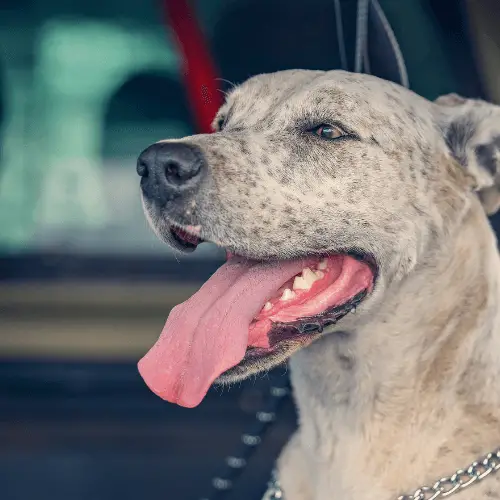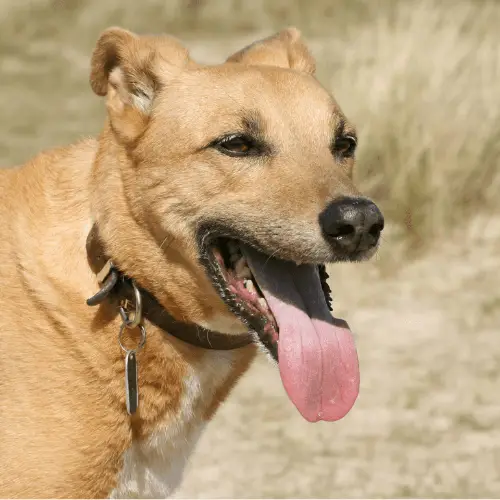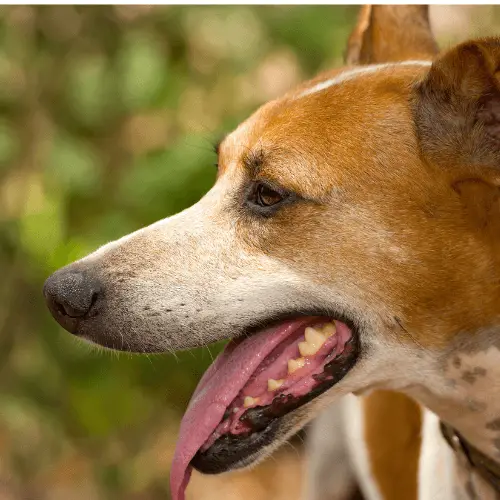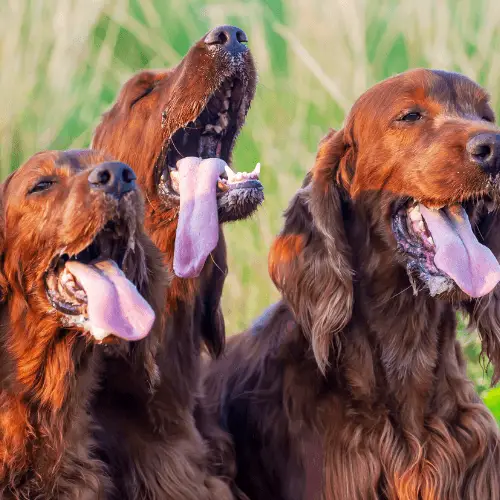Why Is My Dog Panting So Much?
As a dog owner, I’ve often noticed my furry friend panting, and I know it’s a natural behavior for dogs. Panting helps dogs cool down and regulate their body temperature, as they can’t sweat like humans do. However, excessive panting can be a cause for concern and might indicate an underlying issue. In this article, we’ll explore the reasons behind excessive panting in dogs, how to differentiate it from normal panting, and when to seek professional help.

Normal Panting vs. Excessive Panting
As a dog owner, it’s essential to understand the difference between normal and excessive panting in dogs. Here, I’ll explain the key distinctions to help you recognize when your dog’s panting might be a cause for concern.
Normal Panting:
- Occurs during or after exercise, excitement, or warm weather
- Helps regulate body temperature
- Generally quieter and less labored
- Stops when the dog is relaxed and cool
Excessive Panting:
- May occur even when the dog is resting or in a cool environment
- Can be louder, raspier, or more labored than normal panting
- May be accompanied by other symptoms, such as coughing, weight loss, changes in thirst/appetite, or lethargy
- Can be a sign of an underlying health issue, such as pain, anxiety, heart failure, or endocrine disorders
It’s crucial to observe your dog’s panting patterns and take note of any changes. If you notice excessive panting or any accompanying symptoms, it’s a good idea to consult with a veterinarian to determine the cause and ensure your dog’s well-being.
Heat and Overheating

Panting is a crucial mechanism that helps dogs cool down and regulate their body temperature. Unlike humans, dogs don’t have an effective system of sweat glands to cool off. Instead, they rely on panting to release heat and maintain a safe body temperature. Here’s how panting works:
- Dogs pant to evaporate moisture from their tongue and upper respiratory tract
- This evaporation cools the blood vessels beneath the skin
- Panting allows dogs to exchange hot air from their lungs with cooler external air
However, it’s essential to be aware of the dangers of overheating and heatstroke in dogs. When the temperature is very hot, especially when it’s humid, a dog’s body may struggle to cool down effectively through panting alone. In such situations, it’s crucial to monitor your dog and provide them with a cool environment, shade, and fresh water to prevent heatstroke.
Signs of heatstroke in dogs include:
- Excessive panting and drooling
- Rapid heart rate
- Weakness or collapse
- Vomiting or diarrhea
- Seizures or disorientation
If you notice any of these signs, it’s essential to take immediate action to cool your dog down and seek veterinary assistance. Remember, prevention is always better than cure, so be proactive in keeping your dog cool and comfortable during hot weather.
Anxiety, Stress, and Fear

Dogs, just like humans, can experience a range of emotions, including anxiety, stress, and fear. These emotional states can have a significant impact on their behavior, including panting. Let’s explore the connection between panting and emotional states in dogs.
Anxiety and Stress:
- Dogs may pant excessively when they feel anxious or stressed
- Common triggers include loud noises, unfamiliar environments, or separation from their owner
- Panting can be a coping mechanism to help dogs self-soothe and calm down
Fear:
- Fearful situations, such as thunderstorms or encounters with other animals, can cause excessive panting in dogs
- Panting can be a sign of a dog’s heightened arousal and stress response in these situations
To help your dog cope with anxiety, stress, or fear, consider the following strategies:
- Create a safe and comfortable environment for your dog, such as a designated “safe space” in your home
- Use positive reinforcement and training techniques to help your dog build confidence and overcome fears
- Consider using calming aids, such as pheromone diffusers or calming treats, to help reduce anxiety
- Consult with a veterinarian or a professional dog behaviorist for personalized guidance and support
By understanding the connection between panting and emotional states in dogs, you can better support your furry friend’s well-being and help them navigate stressful situations.
Pain and Discomfort

Excessive panting can be a sign of pain or discomfort in dogs. When our furry friends are in pain, they might not always show it in ways we can easily recognize. Panting can be one of the subtle indicators that something is wrong. Here are some situations where excessive panting might be linked to pain or discomfort:
- Injuries: If your dog has suffered a recent injury, they might pant excessively due to the pain they’re experiencing.
- Arthritis: Joint pain caused by arthritis can lead to excessive panting, especially in older dogs.
- Toothache: Dental issues, such as tooth decay or gum disease, can cause pain and lead to increased panting.
- Internal pain: Conditions like cystitis or gastrointestinal issues can cause internal pain, which might result in excessive panting.
It’s essential to observe your dog closely and look for other signs of pain or discomfort, such as limping, reluctance to move, changes in appetite, or unusual behavior. If you suspect your dog is in pain, it’s crucial to consult with a veterinarian to determine the cause and provide appropriate treatment to ensure your dog’s well-being.
Health Conditions
Various health conditions can cause excessive panting in dogs. It’s essential to be aware of these conditions to ensure your dog’s well-being. Here are some health issues that can lead to excessive panting:
- Heart Failure: When a dog’s heart isn’t functioning properly, it can cause a build-up of fluid in the lungs, leading to panting. Other symptoms may include lethargy, weakness, and coughing.
- Lung Disease: Respiratory issues such as laryngeal paralysis, infections, and cancer can contribute to excessive panting. Diagnostics like X-rays might be needed, with treatment depending on the cause.
- Endocrine Disorders: Conditions like Cushing’s disease can cause excessive panting in dogs. Dogs with this condition may also develop a pot-bellied appearance, have excessive thirst and urination, and their skin and coat may look unthrifty.
- Anemia: Dogs with anemia may pant excessively due to a lack of oxygen in their blood. They might also be lethargic, lose their appetite, and appear nauseous.
If you notice your dog panting excessively, it’s essential to consult with a veterinarian to determine the underlying cause and provide appropriate treatment. Early detection and intervention can help ensure your dog’s health and well-being.
Pregnancy and Panting
Panting can be related to pregnancy in dogs, as it may serve as an indicator of various stages and conditions during the gestation period. Let’s explore the relationship between panting and pregnancy in dogs:
- Pregnancy stages: As dogs progress through pregnancy, their bodies undergo significant changes, which may cause panting. This can be a normal response to the increased demands on their bodies.
- Nesting behavior: As a dog’s due date approaches, she may start to exhibit nesting behavior, which can include panting, pacing, and refusing food. This is a sign that labor is imminent.
- Labor and delivery: During labor, a dog may pant as a response to the physical exertion and pain associated with contractions. Panting can also help the dog stay calm and focused during the birthing process.
- Postpartum complications: After giving birth, a dog may pant excessively due to complications such as eclampsia (a life-threatening drop in blood calcium levels). This condition requires immediate veterinary attention.
It’s essential to monitor your pregnant dog closely and be aware of any changes in her panting patterns. If you notice excessive panting or any other concerning symptoms, consult with a veterinarian to ensure the health and well-being of both the mother and her puppies.

Nighttime Panting
Excessive panting at night can be concerning for dog owners, as it might indicate an underlying issue that needs attention. Here are some reasons behind nighttime panting and how to address them:
- Temperature: Ensure your dog’s sleeping area is cool and well-ventilated. If the environment is too hot, your dog may pant excessively to cool down. Provide fresh water and consider using a cooling mat or fan to help maintain a comfortable temperature.
- Anxiety and stress: Nighttime panting may be related to stress or anxiety. Create a calm and relaxing environment for your dog by providing a comfortable bed, reducing noise, and using calming aids such as pheromone diffusers or calming treats.
- Pain or discomfort: If your dog is experiencing pain or discomfort, they may pant excessively at night. Observe your dog for other signs of pain, such as limping or changes in behavior, and consult with a veterinarian if necessary.
- Health conditions: Certain health conditions, such as heart failure, lung disease, or endocrine disorders, can cause excessive panting at night. If you suspect an underlying health issue, seek veterinary advice for proper diagnosis and treatment.
- Sleep disturbances: Some dogs may pant at night due to sleep disturbances or changes in their sleep patterns. Ensure your dog has a consistent sleep schedule and a comfortable, quiet place to rest.
By addressing these potential causes of nighttime panting, you can help ensure your dog’s well-being and improve their quality of sleep.
When to Consult a Veterinarian
It’s essential to know when to seek professional help for excessive panting in dogs. Here are some situations where you should consult a veterinarian:
- Unexplained panting: If your dog is panting excessively without an obvious cause, such as exercise or heat, it’s a good idea to consult a veterinarian.
- Accompanying symptoms: If excessive panting is accompanied by other symptoms, such as coughing, weight loss, changes in thirst or appetite, or lethargy, it’s essential to seek veterinary advice.
- Panting at rest: If your dog is panting excessively while resting or sleeping, it may indicate an underlying health issue that requires professional attention.
- Sudden onset: If your dog suddenly starts panting excessively, especially if it’s accompanied by shaking or restlessness, consult a veterinarian as soon as possible.
By being proactive and seeking veterinary advice when needed, you can ensure your dog’s health and well-being. Remember, early detection and intervention can make a significant difference in your dog’s quality of life.
Conclusion
Excessive dog panting can be a cause for concern, as it may indicate an underlying issue that requires attention. Throughout this article, we’ve discussed the differences between normal and excessive panting, the role of panting in regulating body temperature, and the connection between panting and emotional states like anxiety, stress, and fear. We’ve also explored how panting can be a sign of pain or discomfort, various health conditions that can cause excessive panting, and the relationship between panting and pregnancy in dogs.
It’s essential to monitor your dog’s panting patterns and be aware of any changes. If you notice excessive panting, especially when accompanied by other symptoms or occurring at night, consult with a veterinarian to determine the cause and provide appropriate treatment. By being proactive and attentive to your dog’s needs, you can ensure their health and well-being.
Frequently Asked Questions
- What is the difference between normal and excessive panting in dogs? Normal panting occurs during or after exercise, excitement, or warm weather and helps regulate body temperature. Excessive panting may occur even when the dog is resting or in a cool environment and can be a sign of an underlying health issue.
- How does panting help dogs cool down? Panting helps dogs cool down by evaporating moisture from their tongue and upper respiratory tract, which cools the blood vessels beneath the skin and allows them to exchange hot air from their lungs with cooler external air.
- Can anxiety or stress cause excessive panting in dogs? Yes, dogs may pant excessively when they feel anxious or stressed. Common triggers include loud noises, unfamiliar environments, or separation from their owner.
- How can I tell if my dog’s panting is due to pain or discomfort? Observe your dog for other signs of pain, such as limping, reluctance to move, or changes in appetite. If you suspect your dog is in pain, consult with a veterinarian.
- What health conditions can cause excessive panting in dogs? Health conditions that can cause excessive panting include heart failure, lung disease, endocrine disorders, and anemia.
- Is panting normal during pregnancy in dogs? Panting can be related to pregnancy in dogs, as it may serve as an indicator of various stages and conditions during the gestation period, such as nesting behavior, labor, and postpartum complications.
- Why is my dog panting excessively at night? Nighttime panting can be caused by factors such as temperature, anxiety, stress, pain, discomfort, or underlying health conditions. Addressing these potential causes can help improve your dog’s sleep quality.
- When should I consult a veterinarian about my dog’s panting? Consult a veterinarian if your dog’s panting is unexplained, accompanied by other symptoms, occurs at rest, or has a sudden onset.
- How can I help my dog if they are panting excessively due to anxiety or stress? Create a safe and comfortable environment for your dog, use positive reinforcement and training techniques, consider using calming aids, and consult with a veterinarian or a professional dog behaviorist for personalized guidance and support.
- What should I do if my dog is panting excessively due to heat? Ensure your dog has access to a cool environment, shade, and fresh water. Monitor your dog for signs of heatstroke, such as excessive drooling, rapid heart rate, or collapse, and seek veterinary assistance if needed.
- How can I tell if my dog’s panting is due to heatstroke? Signs of heatstroke in dogs include excessive panting and drooling, rapid heart rate, weakness or collapse, vomiting or diarrhea, and seizures or disorientation.
- What can I do to help my dog if they are panting due to anxiety or stress? Create a safe and comfortable environment, use positive reinforcement and training techniques, consider using calming aids, and consult with a veterinarian or a professional dog behaviorist for personalized guidance and support.
- Are certain dog breeds more prone to excessive panting? Some dog breeds may be more prone to excessive panting due to factors such as their size, coat type, or genetic predisposition to certain health conditions.
- Can obesity contribute to excessive panting in dogs? Yes, obesity can contribute to excessive panting in dogs, as it puts additional strain on their respiratory and cardiovascular systems.
- How can I prevent heatstroke in my dog to avoid excessive panting? Ensure your dog has access to a cool environment, shade, and fresh water during hot weather. Monitor your dog for signs of heatstroke and seek veterinary assistance if needed.
- What tests might a veterinarian perform to determine the cause of excessive panting? A veterinarian may perform tests such as blood work, X-rays, or an examination to determine the cause of excessive panting in dogs.
- Can excessive panting be a sign of an underlying hormonal issue in dogs? Yes, excessive panting can be a sign of an underlying hormonal issue, such as Cushing’s disease or other endocrine disorders.
- How can I help my dog if they are panting excessively due to an unknown cause? Consult with a veterinarian to determine the cause of excessive panting and provide appropriate treatment to ensure your dog’s well-being.
- Why is my dog panting and whining? Panting and whining can be signs of pain, discomfort, anxiety, or stress in dogs. Observe your dog for other symptoms and consult with a veterinarian if necessary.
- Why is my dog panting and pacing? Panting and pacing can be signs of pain, discomfort, anxiety, or stress in dogs. Observe your dog for other symptoms and consult with a veterinarian if necessary.
Hi, I’m John and I love dogs. Ever since I was a kid, I always wanted to have a furry friend by my side. I grew up with a golden retriever named Max, who taught me a lot about loyalty, friendship, and fun. He was my best buddy for 12 years, and I miss him every day.